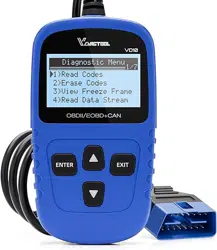
2
1.Safety Precautions and Warnings
To prevent personal injury or damage to vehicles and/or the scan
tool, read this instruction manual first and observe the following
safety precautions at a minimum whenever working on a vehicle:
●
Always perform automotive testing in a safe environment.
●
Do not attempt to operate or observe the tool while driving a vehicle. Operating
or observing the tool will cause driver distraction and could cause a fatal
accident.
●
Keep clothing, hair, hands, tools, test equipment, etc. away from all moving or
hot engine parts.
●
Wear safety eye protection that meets ANSI standards.
●
Operate the vehicle in a well ventilated work area: Exhaust gases are
●
Use extreme caution when working around the ignition coil, distributor cap,
ignition wires and spark plugs. These components create hazardous voltages
●
Put the transmission in PARK (for automatic transmission) or NEUTRAL
(for manual transmission) and make sure the parking brake is engaged.
●
Keep the scan tool dry, clean, free from oil/water or grease. Use a mild
detergent on a clean cloth to clean the outside of the scan tool, when Necessary.
●
Keep a fire extinguisher suitable for gasoline/chemical/electrical fires nearby.
●
Don't connect or disconnect any test equipment while the ignition is on or the
engine is running.
when the engine is running.
Poisonous.Poisonous.
3
2.General Information
2.1 On-Board Diagnostics (OBD) II
2.2 Diagnostic Trouble Codes (DTCs)
1) Whether the Malfunction Indicator Light (MIL) is commanded 'on' or 'O';
2) Which, if any, Diagnostic Trouble Codes (DTCs) are stored;
3) Readiness Monitor status.
The first generation of On-Board Diagnostics (called OBD I) was developed by
the California Air Resources Board (CARB) and implemented in 1988 to monitor
some of the emission control components on vehicles. As technology evolved and
the desire to improve the On-Board Diagnostic system increased, a new generation
of On-Board Diagnostic system was developed. This second generation of
The OBD II system is designed to monitor emission control systems and key
engine components by performing either continuous or periodic tests of specific
components and vehicle conditions. When a problem is detected, the OBD II system
turns on a warning lamp (MIL) on the vehicle instrument panel to alert the driver
typically by the phrase “Check Engine” or “Service Engine Soon”. The system will
also store important information about the detected malfunction so that a
technician can accurately find and fix the problem. Here below follow three pieces
OBD II Diagnostic Trouble Codes are codes that are stored by the on-board
computer diagnostic system in response to a problem found in the vehicle. These
codes identify a particular problem area and are intended to provide you with a
guide as to where a fault might be occurring within a vehicle. OBD II Diagnostic
Trouble Codes consist of a five-digit alphanumeric code. The first character, a letter,
identifies which control system sets the code. The other four characters, all
numbers, provide additional information on where the DTC originated and the
operating conditions that caused it to be set. Below is an example to illustrate the
On-Board Diagnostic regulations is called "OBD II".
of such valuable Information:
structure of the digits:
1
1. Safety Precautions and Warnings
2.1 On-Board Diagnostics (OBD) II
2.2 Diagnostic Trouble Codes (DTCs)
2.3 Location of the Data Link Connector (DLC)
2.4 OBD II Readiness Monitors
2.5 OBD II Monitor Readiness Status
2.6 OBD II Definitions
3.Using the Scan Tool
3.1 Tool Description - OBD VD10
3.2 Specifications
3.3 Included
3.4 Welcome
3.5 Setup
3.6 Language
........................................................................................8
.................................................................................................................9
..........................................................................................................................9
................................................................................................................10
............................................................................................................................10
.....................................................................................................................10
..................................................................................................................12
.................................................................................................................14
......................................................................................................15
.......................................................................................................15
...............................................................................................................16
...................................................................................................................17
2.General Information
4.OBD II Diagnostics
4.1 Read Codes
4.2 Erase Codes
4.3 View Freeze Frame
4.4 Read Data Stream
4.5 I/M Readiness
4.6 Vehicle Info
5.Warranty and Service
5.1 Limited One Year Warranty
5.2 Service Procedures
...................................2
..........................................................3
......................................................................................3
.................................................................................3
...................................................................4
...........................................................................................5
..................................................................................6
...........................................................................................................6
.........................................................8
.........................................................12
.....................................................18
...........................................................................................18
......................................................................................................18
Table of Contents
OBD VD10
User’s Manual
Loading ...
Loading ...
Loading ...
